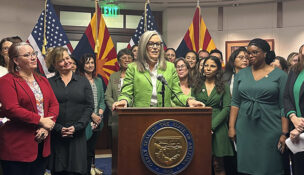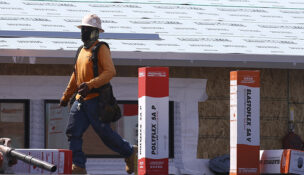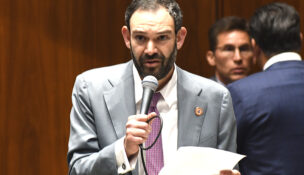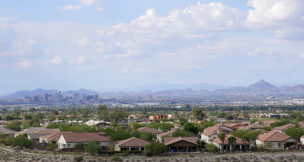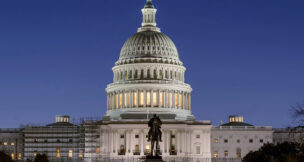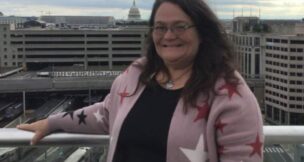How did Arizona get its name?
Arizona Capitol Reports Staff//August 11, 2006//[read_meter]

All in the past
Don Langlois, Arizona history librarian at the Capitol, has everything from an 1869 book on Kit Carson to a sizable collection of Arizona high school year books.
As the Arizona history librarian, Don Langlois has thousands of books at his fingertips.
Some are rare. Some are obscure – like the one that lists all known skirmishes with Indians from 1837 to 1891. The books are crammed into the third floor mezzanine of the 1938 Capitol addition. The collection falls under the administration of the Arizona State Library, Archives and Public Records, an arm of the Arizona Legislature.
Here, Mr. Langlois (pronounced LANG-lwa) tracks down the answers to the public’s persistent questions about Arizona’s past.
He has no pat answer, however, to the most oft-asked question: What is the origin of Arizona’s name?
“It has been said that we’re the only state that doesn’t really know why we’re called what we’re called,” Mr. Langlois told a visitor.
But Mr. Langlois does not duck the question. He has fit three citations offering competing theories onto a single page, suitable for e-mailing. It’s a stock answer for a stock question. Librarians used to work the phones, he said. Now he provides answers by e-mail.
He printed the page. The bottom citation offered the latest theory about “Arizona.” It argued that the name is Basque, coined by a prospector from that region of Spain. The word referred to the oak tree he was camped under, according to this theory. Another writer said it came from a Papago — or Tohono O’odham — word for “little spring.”
As for the third citation, that came from an 1892 letter from James Ashley, chairman of the Committee on Territories. He wrote: “I selected the name ‘Arizona’ because it described the arid plains of that territory and because it was appropriate and euphonious.”
Mr. Langlois does not seem too impressed by this last claim, however.
“This Basque business … is more interesting,” said Mr. Langlois, 65.
A cheerful man, Mr. Langlois has something of a squinting, elfin smile. And clearly, he enjoys the work. If somebody asks a question, he’s glad to help. No question is an imposition, though he does get the occasional query that has no answer.
One man from Indiana wrote: “My mother got something in the mail from some library in Arizona.” It was sometime around 1979, he added. The man wanted to know what it was that the unnamed library sent. The question was too vague and Mr. Langlois was stumped.
Many questions come from state lawmakers. The state library itself was set up in 1865 as a creature of the territorial Legislature.
Collection is older than the state
“Our collection here is older than the state of Arizona,” Mr. Langlois said. “Some of our books actually have the territorial library stamp inside them.” The state is 94.
New books keep coming, though. The collection acquires some 20 to 30 titles a month, Mr. Langlois says. Some are donated. In some cases, authors agree to give the library two copies of a book in exchange for use of material like photographs. Other books are purchased, from a $23,000 fund that also goes toward putting the library’s newspaper collection on microfilm.
In this library, that’s a lot of newspapers.
“We have the best collection of Arizona newspapers in the state,” Mr. Langlois said.
Putting the collection on microfilm will help preserve it, he added. Newspapers printed during World War II are in particular danger, because the newsprint used then had a high content of corrosive sulfur.
“That is the worst,” he said. “The 1915 paper might actually be better than the paper in 1942.”
The microfilmed newspapers are housed in a separate area. Mr. Langlois was keen to give a visitor a tour of the books, though. He unlocked a door that said “staff only” and led the way into a back-room warren of shelves. Before he started down a narrow corridor, though, he turned and sized up his guest — literally. He pointed to a low concrete beam on a low ceiling.
“Watch out for this,” he said. “I can just barely clear it, and believe me if you hit that…”
From Mars to Wyatt Earp
With that warning, he headed to one of his personal favorites. From the shelf, he pulled out “Mars and Its Canals” by Percival Lowell, who founded the observatory in Flagstaff that now bears his name. The book was donated by Mr. Lowell’s widow in 1938 and has a handwritten note by her inside the cover.
“We have lot of things that were autographed, signed by authors – that sort of thing,” Mr. Langlois says.
As was the style in those days, the Lowell book was signed, “Mrs. Percival Lowell.”
In jest, Mr. Langlois added: “Whatever her first name is, I have no idea.”
He then went from his personal favorite to the popular favorite – the Wyatt Earp collection, covering Wyatt and his brothers. New Earp books keep coming in, he said.
Mr. Langlois then held up a Wyatt Earp book big enough to flatten squirrels.
He added: “The books keep getting bigger and bigger and when you get something like this — Lee Silva’s book, ‘Volume One, The Cowtown Years’ – you think, oh my gosh, this is Wyatt before he got to Tombstone.”
Still, he’s glad to have books about all things Earp.
“It’s a popular topic, and let’s face it, where would Tombstone be today without the Earps?”
But the bigger the book, the harder it is to find room for it. He has just about run out of room. To save shelf space, he has had to place books behind books.
“I just have to know something is back there,” he said.
Some books are set flat atop the books already in the shelf. There’s just no room to squeeze them in.
“We’re jammed,” he said. “We’re waiting for the new archive building.”
New archive building
The Legislature has approved $38 million for construction of a new history and archives building on Jefferson west of 19th Avenue, but construction has not begun.
Mr. Langlois moved on down the stacks. He stopped to pluck out a book on the life of Kit Carson, published in 1869.
“Probably should go in the rare book collection, but I don’t have room to put it in that,” he says.
Some rare books, he added, are in a vault.
Many of them can’t be replaced. And Mr. Langlois wants to be sure he has all his resources lined up when legislators call. After all, they’re the boss.
On a recent morning, for example, he offered to help a regular caller – after he answered a state senator’s question about Hugo Oconor.
Curious, the caller asked: What about Hugo Oconor, aside from his odd name spelling? Well, he was the Irishman who founded Tucson in 1775.
Not many people know that – outside of Mr. Langlois.






